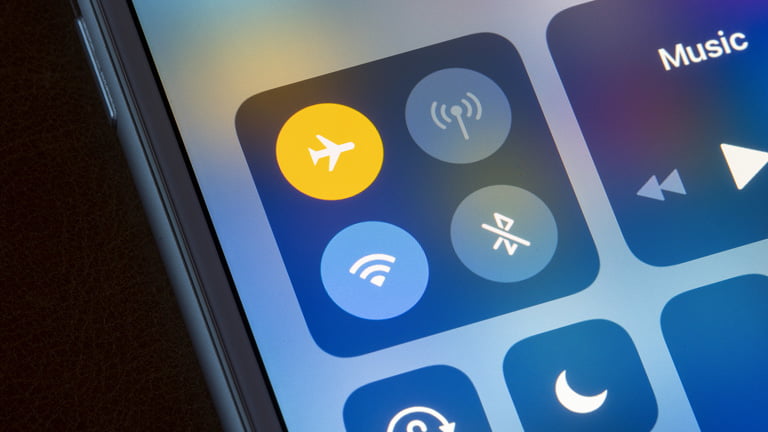
If you plan to travel to another country, one of the first things you must figure out is how to stay in touch with your loved ones back home. To stay connected, your device needs to be connected to the internet either via a mobile cellular connection or WiFi. Otherwise, you may have to put your phone in airplane mode.
Most modern smartphones come with the airplane mode feature, which disables wireless communication to and from the device, including cellular data, Wi-Fi, and Bluetooth. Many users may still wonder does airplane mode use data, particularly when traveling internationally.
In this article, we will discuss everything you need to know about using airplane mode and what you should and shouldn’t do with your phone when traveling internationally.
What is airplane mode?
Airplane mode, also known as flight mode, is a feature on modern mobile devices that disables wireless connections, including WiFi, Bluetooth and cellular data. However, on some newer devices and operating systems, airplane mode doesn’t disable Bluetooth. Airplane mode is typically used during flights to comply with regulations and prevent interference with aircraft equipment.
When you turn on airplane mode, you won’t be able to use any features on your device that require connecting to the internet. However, you can still use the non-wireless features and apps on your device, such as playing offline games or listening to offline music.
How do I turn airplane mode on?
Turning on airplane mode depends on the kind of mobile device you have and its operating system.
Turning on airplane mode on iPhone and iPad
To turn on airplane mode on an iPhone or iPad, swipe down from the top right corner of the screen and tap the airplane mode icon. For older iOS devices with the home button, swipe up from the bottom of the screen to access the control center. Alternatively, go to [Settings] – [Airplane Mode], and toggle the switch to turn it on.
Turning on airplane mode on Android devices
To turn on airplane mode on an Android device, swipe down from the top of the screen to access the notification panel, then tap the airplane mode icon (the icon resembles an airplane). Alternatively, go to [Settings] – [Network & internet] – [Airplane mode], and toggle the switch to the “on” position.

When do I use airplane mode?
As mentioned earlier, you will typically use airplane mode during flights to comply with regulations and prevent interference with aircraft equipment. However, it can also be useful in other situations, such as when you want to conserve battery life by only using offline features and apps on your devices.
You may also want to turn on airplane mode when you are in an area with a poor signal and do not want your device to constantly search for a connection. Turning on airplane mode may also be an option if you’re overwhelmed and don’t want to receive calls, text messages, and push notifications from apps. Finally, you can turn airplane mode on and then off after a few seconds if you want to reset your mobile network connection.
Does airplane mode use data?
When airplane mode is turned on, it turns off all wireless communication, including cellular data. This means that your device will not use any data while in airplane mode since you’re not sending or receiving any information from the internet. Mobile devices typically consume data when sending or receiving data from the internet. If no data is sent or received, you won’t lose any data from your data bundle.

What shouldn’t / should I do with my phone when traveling overseas?
Here are some of the things you should do and those that you shouldn’t do when using your phone in another country.
3 things you shouldn’t do with your phone overseas
- Just turn on airplane mode
Turning on airplane mode may be an effective way to disable wireless communication and save battery life. However, it will prevent you from accessing useful features and information while traveling. For instance, if you want to navigate using apps like Google Maps, you will have to turn off airplane mode to get a signal.
Similarly, if you want to use Wi-Fi to connect to the internet, you will need to turn off airplane mode or manually turn on WiFi mode, since WiFi is also disabled when you turn on airplane mode. Overall, airplane mode should only be enabled when on a plane or when you intentionally don’t want to receive and send data to the internet.
- Only rely on auto-roaming
Auto-roaming is a feature that allows your phone to automatically connect to a supported local cellular network when you’re in another country. While this can be convenient, it can also be expensive, as many carriers charge high rates for international roaming. Average data prices for roaming range between $2 to $5 per MB, which is way too expensive when compared to the local cellular data rates.
- Only rely on WiFi
Using Wi-Fi will obviously save you money on data usage while traveling. However, it’s important to be aware of the risks of using public Wi-Fi networks. Free Wi-Fi networks can be insecure, making your device vulnerable to hacking and data theft. Additionally, many public Wi-Fi networks may not be available in certain locations or may require a password or payment to access. When you travel, it’s important to have a backup plan for accessing the internet, such as using local eSIM networks in case you don’t have access to WiFi or if you don’t trust the WiFi networks within your vicinity.
3 things you should do with your phone overseas
- Check your phone status to ensure it is unlocked.
If you plan to travel soon, it’s important to check if your phone is unlocked. When a phone is unlocked, it can connect to any local carrier network in a foreign country. This will save you money that you would otherwise spend on international roaming charges. The easiest way to check if your phone is unlocked is by using a SIM card or eSIM of another carrier.
- Learn how to manage data roaming settings.
If you intend to use cellular data (which you should) while traveling, it’s important to learn how to manage your data roaming settings. Almost every smartphone has a feature that allows you to turn off data roaming to avoid unexpected charges. We recommend turning off this feature if you don’t want to pay the enormous charges of data roaming.
- Prepare for a data plan for an international traveler
If you intend to use your smartphone or other devices to access the internet in a foreign country, it’s important to determine the data plan that suits your needs and budget. More about this in the next section.
What is the best way to use data overseas?
If you want to stay connected to the internet when you travel, here are some of the options that you might consider.
- Portable WiFi devices
These devices are small routers that create a WiFi hotspot that you can connect to with your smartphone or other devices. However, they can be expensive to purchase, and you may still have to pay for data usage beyond the limits of your plan.
- Physical SIM card
SIM cards are a popular option for international travelers because they allow you to use your phone on a local network in the destination country. Using local SIM cards is a cost-effective way to stay connected, especially if you plan to make local calls or send text messages in addition to connecting to the internet.
- Auto data roaming
When using auto data roaming, your smartphone automatically connects to a local network in the destination country, allowing you to use cellular data as you would at home. While this can be a convenient option, it is usually very expensive than the other alternatives.
- Traveler eSIM
eSIM is a new technology that allows you to activate a cellular plan without having to physically insert a SIM card into your device. Activating eSIM is done by downloading and installing activation software or requesting your network provider to activate it remotely. eSIMs are becoming increasingly popular among international travelers because they are easy to use and offer many advantages over traditional SIM cards, including:
- Reasonable prices: eSIMs are often priced competitively compared to traditional SIM cards, especially for data usage.
- Prepaid: eSIMs can be prepaid, so you don’t have to worry about hidden fees or unexpected charges.
- Easy to use: eSIMs can be activated quickly and easily without visiting a local store to purchase and install a physical SIM card.
- Flexibility: eSIMs can be used with multiple carriers, giving you more options for choosing the best plan for your needs.
Overall, using eSIM is the best alternative, thanks to the advantages they have over the other options we have shared. The good news is that all the popular carriers in the US and Europe support eSIM. If you plan to travel to the US, check out various plans from eSIM USA to get access to some of the best eSIM data plans.
Final thoughts
As discussed in this article, airplane mode is only necessary if you are on a plane or intentionally don’t want your device to connect to the internet or receive calls and texts. Consider turning it off if you want to stay connected to the internet. To use the internet in a foreign country, there are several other options available, including SIM cards, portable WiFi devices, and auto data roaming.
However, prepaid eSIM is the safest and easiest way to use data overseas, offering affordable and reliable connectivity without going through the hassle of purchasing and installing traditional SIM cards. eSIM USA offers a wide range of eSIM data plans that you can take advantage of if you intend to travel to the USA soon.



